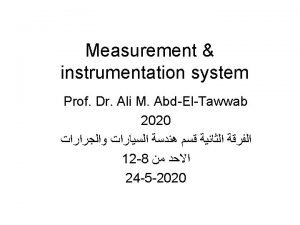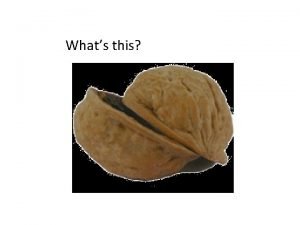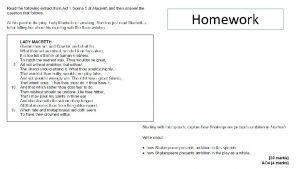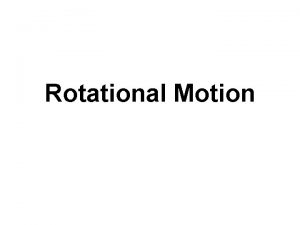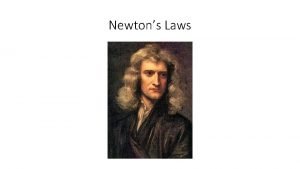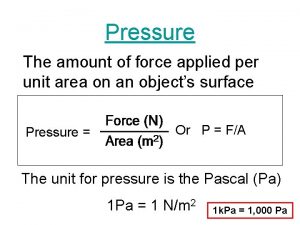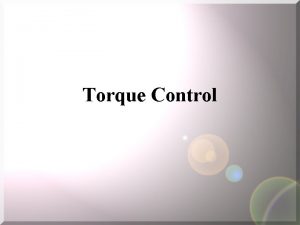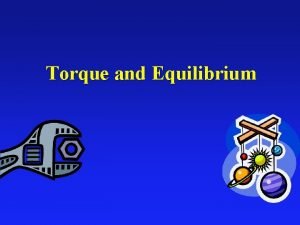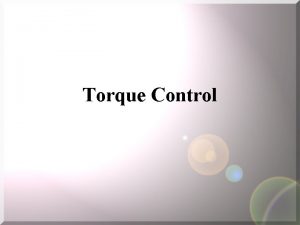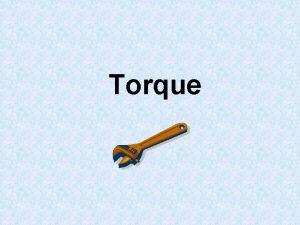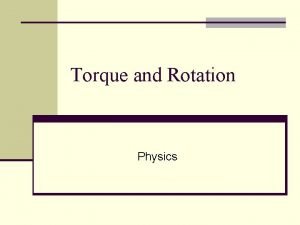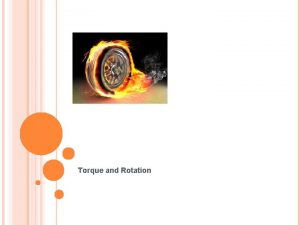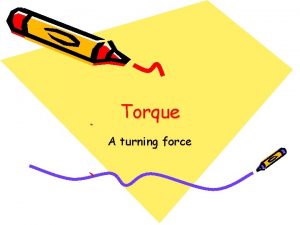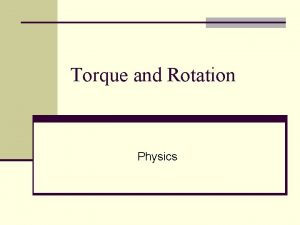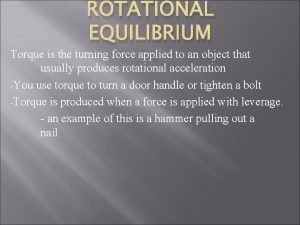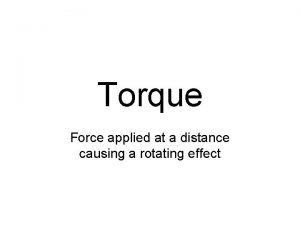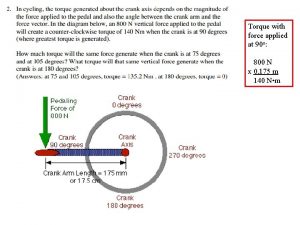TORQUE Torque applied force required to turn or
















- Slides: 16

TORQUE Torque: applied force required to turn or rotate an object around a fixed position. A twisting force that causes an object to turn. • Turning a screwdriver • Tightening a bolt or nut on fastener • Belt causing a cog or wheel to rotate • A lever turning around a fulcrum

Calculating Torque = Perpendicular Force x Lever Length Γ = Torque (Nm Newton-meter) F┴= Perpendicular force (N) l = lever length (m)

Lever length is the length of the tool that is used to turn the object—from the pivot point (fulcrum) to the place where the force is applied. • Length of the wrench • Length of the ratchet • Length of the pry bar or crowbar • Radius of the screwdriver Pivot point or fulcrum l F┴

A lever is one example of a simple machine. Effort force is reduced at the expense of greater distance. • Longer the lever, the lesser the perpendicular force required to turn the object. • Shorter the lever, the greater the perpendicular force required to turn the object.

Γ = Torque (Nm) F┴= Perpendicular force (N) l = lever length (m) Pedro uses a wrench to tighten a bolt. The length of the wrench is 0. 20 meters. The force required to tighten the bold is 16 N. Calculate the torque applied to the bolt.

Γ = Torque (Nm) F┴= Perpendicular force (N) l = lever length (m) Jerome uses a wrench to tighten a bolt. The length of the wrench is 0. 25 meters. The torque applied to the bolt is 2. 2 Nm. Calculate the perpendicular force required to tighten the bolt.

Balancing a Lever (Static Equilibrium) Lever length Pivot Force on left side (weight) Force on right side (weight) For a seesaw or lever to have static equilibrium, the opposing torques must be equal in magnitude and opposite in direction.

Balancing a Lever (Static Equilibrium) Lever length Pivot Force on left side (weight) Force on right side (weight)

Weight is the downward force of an object under Earth’s gravity field. Weight (force) = mass x gravity field = m·g On Earth’s surface, Earth’s gravity field is 9. 81 m/s 2.

Lever length Pivot Force on left side (weight) Force on right side (weight) If the lever lengths are equal, the masses of the objects are equal, and the weights (perpendicular forces) of the objects are equal.

Lever length Pivot What if the lever lengths are not equal in length? Which object has greater mass and greater weight? Left or Right? Explain why?

Center of Mass: The relative position in a mass system where the mass distribution on either side is equal. The sum products of mass x length on either side of the center of mass must be equal. Smaller mass Larger mass Unequal masses Smaller mass Equal masses

Lever length Object 1 Mass = 10 kg l = 2 meters Pivot Object 2 Mass = 20 kg l=? The seesaw is at static equilibrium. Calculate the lever length between the pivot and object 2 such that it balances the seesaw.

Lever length Object 1 Mass = 10 kg l = 1. 5 meters Lever length Pivot Object 2 Mass = 8 kg The seesaw is at static equilibrium. Calculate the lever length between the pivot and object 2 such that it balances the seesaw.

Lever length Object 1 Mass = 20 kg l = 1. 2 meters Pivot The seesaw is at static equilibrium. You must place a 25 kg block on the seesaw to balance it. • Calculate the lever length between the block and the pivot. • Calculate the torque on the right side of the seesaw.

Warm Up Calculate lever lengths for the counterbalancing mass. Lever length Object 1 Mass = 10 kg l = 1. 0 meter Pivot Where would you place a 20 kg mass? Where would you place a 30 kg mass? Where would you place a 50 kg mass?
 Applied torque
Applied torque Themes about guilt
Themes about guilt You can't turn right here. you turn left
You can't turn right here. you turn left What does o valiant cousin worthy gentleman mean
What does o valiant cousin worthy gentleman mean Tomato flames
Tomato flames Wash your hands put on your nightgown analysis
Wash your hands put on your nightgown analysis Turn hell hound turn
Turn hell hound turn Put your right hand in
Put your right hand in Answer. go straight turn left turn right
Answer. go straight turn left turn right Turn right turn left go straight worksheet
Turn right turn left go straight worksheet Walk straight and turn left
Walk straight and turn left What is 1/4 turn clockwise
What is 1/4 turn clockwise What is the difference between torque and force
What is the difference between torque and force Mcq on dynamometer
Mcq on dynamometer At the end of the giant drop free fall
At the end of the giant drop free fall Force applied
Force applied A water glass sitting on a table weighs 4n
A water glass sitting on a table weighs 4n
